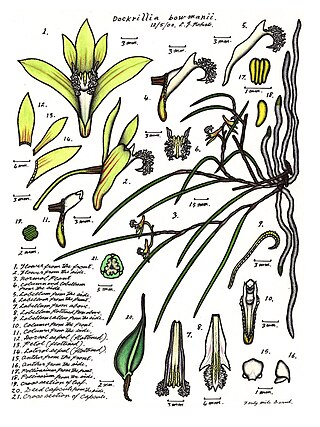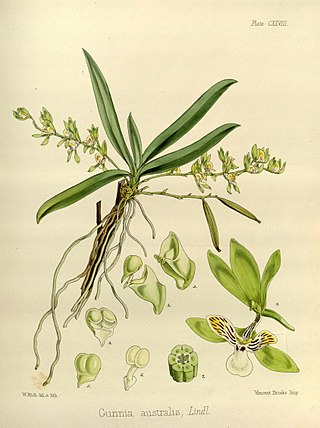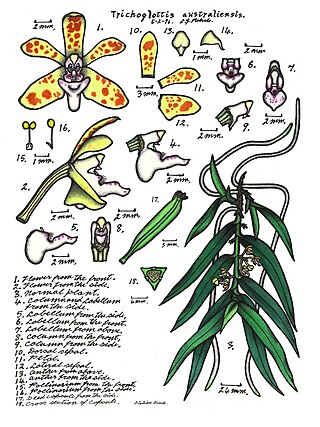
Papillilabium beckleri, commonly known as the imp orchid, is the only species in the genus Papillilabium from the orchid family, Orchidaceae. It is a small, epiphytic orchid with many thin roots, between two and six linear leaves and up to eight pale green or brownish flowers. The flowers are fragrant, produce nectar and have a warty labellum. It grows on shrubs and trees in humid places and near streams and is found between south-east Queensland and the Sydney region in New South Wales.
Brachypeza archytas, commonly known as the sage orchid, is an epiphytic orchid that is endemic to Christmas Island, an Australian territory in the north-eastern Indian Ocean. It has many cord-like roots, four or five leaves arranged like a fan and a large number of small, crowded, short-lived, white flowers.
Dendrobium nativitatis, commonly known as the Christmas Island crimp orchid, is a species of epiphytic orchid that is endemic to Christmas Island, an Australian territory in the north-eastern Indian Ocean. It has long, straggly stems, flattened pseudobulbs, a single leathery leaf and a single pale yellow flower.

Sarcochilus parviflorus, commonly known as the southern lawyer orchid or green tree orchid, is an epiphytic orchid endemic to eastern Australia. It has up to eight rigid leaves and up to twelve small bright green to yellowish green flowers with reddish markings on the labellum.

Dendrobium bowmanii, commonly known as the straggly pencil orchid, is an epiphytic or lithophytic orchid in the family Orchidaceae. It has thin wiry, straggly stems with a small number of small leaves and up to four greenish or brownish flowers with a conspicuous white labellum. It grows in drier rainforests and coastal scrub in New South Wales, southern Queensland and New Caledonia.
Chiloschista phyllorhiza, commonly known as the white starfish orchid, is a species of leafless epiphytic or lithophytic orchid that forms small clumps with many radiating, flattened green roots. A large number of short-lived, crystalline white, star-shaped flowers with a yellow labellum are arranged along thin, arching flowering stems. It occurs in northern parts of Australia where it grows in rainforest, swamps and near streams.

Luisia tristis, commonly known as the velvet orchid, is a species of epiphytic or lithophytic orchid with wiry stems often forming tangled clumps, cylindrical leaves and flowering stems with up to three green flowers with a dark red to dark maroon labellum. This orchid occurs in tropical Asia, New Guinea, Australia and some islands of the Western Pacific Ocean.

Micropera fasciculata, commonly known as the pale dismal orchid, is a species of epiphytic or lithophytic orchid with wiry stems forming large, tangled clumps. It has stiff, leathery leaves and flowering stems with between ten and twenty cream-coloured flowers with a white labellum. This orchid occurs in New Guinea, Queensland, the Solomon Islands and New Caledonia.
Saccolabiopsis armitii, commonly known as the spotted pitcher orchid, is an epiphytic orchid from the family Orchidaceae. It has a short stem, coarse, wiry roots, between three and six crowded, curved leaves and up to fifty yellowish green flowers with red markings and a white labellum. It usually grows in coastal scrub to rainforest in New Guinea and tropical North Queensland, Australia.
Sarcochilus argochilus, commonly known as the northern lawyer orchid, is a small epiphytic orchid endemic to Queensland. It has up to eight thin leaves and up to twelve small bright green to yellowish green flowers with a white labellum.

Sarcochilus australis, commonly known as the butterfly orchid or Gunn's tree orchid, is a small epiphytic orchid endemic to eastern Australia. It has up to ten oblong, dark green leaves and up to fourteen small green to yellowish or brownish flowers with a mostly white labellum.

Sarcochilus borealis, commonly known as the small lawyer orchid, is a small epiphytic orchid endemic to Queensland. It has up to six thin but stiff, dark green leaves and up to ten green flowers with a white labellum that has reddish brown markings.
Sarcochilus dilatatus, commonly known as the brown butterfly orchid, is a small epiphytic orchid endemic to eastern Australia. It has up to twelve, thin, leathery, dark green leaves and up to twelve brown or reddish brown flowers with a mostly white and yellow labellum.

Sarcochilus hirticalcar, commonly known as the harlequin orchid, is a small epiphytic orchid endemic to Queensland. It has up to eight bright green leaves and up to twelve cream-coloured to bright yellow flowers with purplish to reddish brown bands.

Sarcochilus serrulatus, commonly known as the banded butterfly orchid, is an epiphytic orchid endemic to tropical North Queensland. It has up to six crowded leaves with finely toothed and wavy edges and up to ten reddish brown flowers with a white, yellow-banded labellum.
Sarcochilus spathulatus, commonly known as the small butterfly orchid, is a small epiphytic orchid endemic to eastern Australia. It has a single, more or less pendent growth with up to ten thin, leathery leaves and up to five green to dark brown flowers with a cream-coloured labellum that has purple markings.

Sarcochilus weinthalii, commonly known as the blotched butterfly orchid, is a small epiphytic orchid endemic to eastern Australia. It has between three and seven thin, leathery, yellowish green leaves and up to twelve cream-coloured flowers with large purple or reddish blotches.

Thrixspermum congestum, commonly known as the cupped hairseed, is an epiphytic or lithophytic orchid that forms small clumps with many thin roots, up to fifteen leathery leaves and many star-shaped white or cream-coloured flowers. This orchid occurs from Papuasia to northern Australia.
Thrixspermum platystachys, commonly known as the starry hairseed, is an epiphytic or lithophytic orchid that forms untidy clumps with many tangled, wiry roots, up to ten stiff, leathery leaves and many star-shaped, cream-coloured flowers with an orange and white labellum. This orchid occurs from Papuasia to northern Queensland.

Trichoglottis australiensis, commonly known as the weeping cherub orchid, is an epiphytic or lithophytic clump-forming orchid. It has thick, cord-like roots, flattened, branching stems, many thick, leathery, glossy leaves and between two and six creamy yellow flowers with reddish blotches. This orchid only occurs in tropical North Queensland.












